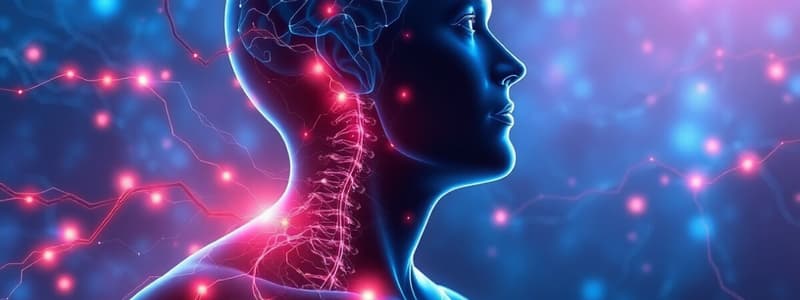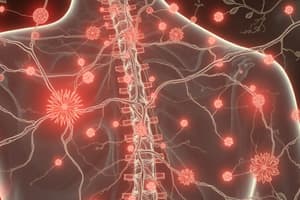Podcast
Questions and Answers
Serotonin blocks the transmission of pain signals at the 'pain gate'.
Serotonin blocks the transmission of pain signals at the 'pain gate'.
True (A)
Opiates are synthetic drugs created in laboratories that target opioid receptors.
Opiates are synthetic drugs created in laboratories that target opioid receptors.
False (B)
The pain pathways from free nerve endings to the somatosensory cortex involve the thalamus.
The pain pathways from free nerve endings to the somatosensory cortex involve the thalamus.
True (A)
Endorphins and enkephalins are examples of exogenous ligands that bind to opioid receptors.
Endorphins and enkephalins are examples of exogenous ligands that bind to opioid receptors.
Gabapentin and pregabalin work by decreasing inflammation.
Gabapentin and pregabalin work by decreasing inflammation.
Which of the following substances is used to reverse opioid overdose?
Which of the following substances is used to reverse opioid overdose?
Fentanyl is less potent than morphine.
Fentanyl is less potent than morphine.
What is Suboxone composed of?
What is Suboxone composed of?
Partial Mu agonists limit _____ depression and abuse potential.
Partial Mu agonists limit _____ depression and abuse potential.
Match the following substances with their primary action:
Match the following substances with their primary action:
Which medication is known for blocking the reuptake of norepinephrine and releasing serotonin?
Which medication is known for blocking the reuptake of norepinephrine and releasing serotonin?
Naltrexone makes heroin ineffective in the body.
Naltrexone makes heroin ineffective in the body.
Which of the following substances blocks the transmission of pain signals at the pain gate?
Which of the following substances blocks the transmission of pain signals at the pain gate?
Opioids are derived solely from natural sources like opium.
Opioids are derived solely from natural sources like opium.
What is the function of mu receptors in opioid action?
What is the function of mu receptors in opioid action?
The juice of the poppy is referred to as ______.
The juice of the poppy is referred to as ______.
Match the endogenous ligands with their respective receptors:
Match the endogenous ligands with their respective receptors:
What is laudanum?
What is laudanum?
Gabapentin decreases nociceptor excitation.
Gabapentin decreases nociceptor excitation.
Name two effects of opioids other than analgesia.
Name two effects of opioids other than analgesia.
Flashcards
Opioid Receptors
Opioid Receptors
Specific protein structures in the brain and body that bind to opioids, producing various effects.
Endogenous Opioids
Endogenous Opioids
Pain-relieving chemicals produced naturally by the body, such as endorphins, enkephalins, and dynorphins.
Opioid Analgesia
Opioid Analgesia
Pain relief achieved through the activation of opioid receptors by both natural and synthetic opioids.
Pain Pathways
Pain Pathways
Signup and view all the flashcards
Descending Anti-pain Pathways
Descending Anti-pain Pathways
Signup and view all the flashcards
Morphine, codeine
Morphine, codeine
Signup and view all the flashcards
Heroin
Heroin
Signup and view all the flashcards
Methadone, Meperidine (Demerol)
Methadone, Meperidine (Demerol)
Signup and view all the flashcards
Naloxone (Narcan)
Naloxone (Narcan)
Signup and view all the flashcards
Naltrexone (ReVia, Trexan)
Naltrexone (ReVia, Trexan)
Signup and view all the flashcards
Buprenorphine (Subutex)
Buprenorphine (Subutex)
Signup and view all the flashcards
Tramadol (Ultram)
Tramadol (Ultram)
Signup and view all the flashcards
Opiate vs Opioid
Opiate vs Opioid
Signup and view all the flashcards
What is the 'pain gate'?
What is the 'pain gate'?
Signup and view all the flashcards
How do Opioids work?
How do Opioids work?
Signup and view all the flashcards
Types of Opioid Receptors
Types of Opioid Receptors
Signup and view all the flashcards
MU receptor effects
MU receptor effects
Signup and view all the flashcards
KAPPA receptor effects
KAPPA receptor effects
Signup and view all the flashcards
DELTA receptor effects
DELTA receptor effects
Signup and view all the flashcards
Study Notes
Pain Pathways
- Pain signals travel from free nerve endings to the spinal cord, then the thalamus, and finally to the somatosensory cortex for location.
- Emotionally perceived aspects of pain (how painful it feels), also travel from free nerve endings to the spinal cord, then the thalamus, and to areas like the hippocampus, amygdala, and cingulate cortex.
Anti-Pain Pathways
- Descending pathways originate in the midbrain, and include serotonin and norepinephrine.
- These neurotransmitters block pain signals at the "pain gate."
- Opioids enhance the effect of serotonin and norepinephrine.
Decreasing Pain with Drugs
- Reduce inflammation (e.g., aspirin, NSAIDs).
- Reduce nociceptor excitation (e.g., gabapentin, pregabalin).
- Reduce neurotransmitter release from nociceptors (e.g., opioids).
- Activate anti-pain pathways (e.g., antidepressants, opioids).
- Influence cognitive and emotional processing (e.g., opioids).
Terminology
- Opium: Juice from a poppy plant.
- Narcotic: Any drug causing sleep.
- Opiate: Drug extracted from Opium (e.g., morphine, codeine).
- Opioid: Endogenous ligand that binds to opioid receptors (e.g., endorphins, enkephalins, dynorphins). The term now commonly applies to both natural and synthetic drugs targeting these receptors.
Opiate Sources
- Opium is sourced from the Papaver somniferum plant.
- Native to Eurasia.
- Used for at least 7000 years.
- Laudanum is a mixture of alcohol and opium.
- Hyppdermic injection (1856) has been associated with "soldier's disease".
Opioid Functions
- Analgesia (pain relief).
- Sleep induction
- Anti-tussive (cough suppressant).
- Regulates intestinal motility.
- Synthesis: Precursor polypeptides are cleaved by enzymes (proteases) into active forms.
- Examples:
- POMC → Endorphin
- Proenkephalin → Enkephalin
- Proendorphin → Endorphin, Dynorphin
- Receptors: Metabotropic (affect intracellular processes). Located in the spinal cord, brainstem, thalamus, basal ganglia, nucleus accumbens, cortex.
Opioid Receptors
- Key receptor subtypes: Mu, Kappa, Delta.
- Endogenous ligands: Endorphin, Dynorphin, Enkephalin.
- Exogenous ligands: Morphine, Naloxone, Salvinorin A, Pentazocine, Kratom
Opioid Drugs
Pure Agonists (Mu)
- Morphine, Codeine, Heroin, Methadone, Meperidine (Demerol)
- Fentanyl and derivatives are 80-500 times more potent than morphine.
Mu Antagonists
- Naloxone (Narcan): Reverse opioid overdose.
- Naltrexone (ReVia, Trexan): Used in treatment to block opioid effects.
Partial Mu Agonists
- Limits respiratory depression, abuse potential. Examples: Buprenorphine (Subutex), Tramadol (Ultram).
- Tramadol also blocks norepinephrine reuptake and releases serotonin, with an active metabolite extending its analgesic effects.
Mixed Agonist-Antagonists
- Weak Mu antagonists + Kappa agonists. Example: Pentazocine (Talwin).
- Dysphoria often limits usefulness.
Mixed Agonist-Antagonist (Partial Mu agonists + Pure Mu Antagonist)
- Suboxone: Buprenorphine + Naloxone.
- Naloxone is inactive orally but active when injected or crushed.
Studying That Suits You
Use AI to generate personalized quizzes and flashcards to suit your learning preferences.




